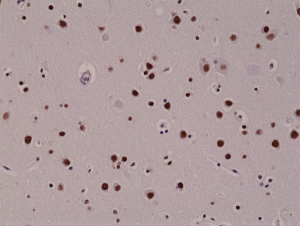
Immunohistochemical staining of formalin fixed and paraffin embedded human brain tissue sections, using rabbit monoclonal anti-5-hmC (clone RM236) antibody.
anti-5-Hydroxymethylcytosine, Rabbit Monoclonal (RM236)
REV-31-1111-00
ApplicationsDot Blot, Flow Cytometry, ELISA, ImmunoCytoChemistry, ImmunoHistoChemistry, Other Application
Product group Antibodies
ReactivityVertebrate
Overview
- SupplierRevMAb Biosciences
- Product Nameanti-5-Hydroxymethylcytosine, Rabbit Monoclonal (RM236)
- Delivery Days Customer10
- ApplicationsDot Blot, Flow Cytometry, ELISA, ImmunoCytoChemistry, ImmunoHistoChemistry, Other Application
- CertificationResearch Use Only
- ClonalityMonoclonal
- Clone IDRM236
- Concentration1 mg/ml
- HostRabbit
- IsotypeIgG
- Scientific Description5-Hydroxymethylcytosine (5hmC) is the first oxidative product in the active demethylation of 5-methylcytosine (5mC). It not only marks active demethylation but also serves as a relatively stable DNA mark that plays distinct epigenetic roles. It is potentially important in epigenetics, because the hydroxymethyl group on the cytosine can possibly switch a gene on and off. 5hmC is abundantly expressed, but the levels vary significantly depending on the cell type. The highest levels are found in neuronal cells of the central nervous system. - Recombinant Antibody. This antibody reacts to 5-hydroxymethylcytosine in both single-stranded and double-stranded DNA. No cross reactivity with non-methylated cytosine and methylcytosine in DNA. Applications: DotBlot, MeDIP, ICC, IHC, ELISA, FC. Source: Rabbit. Liquid. 50% Glycerol/PBS with 1% BSA and 0.09% sodium azide. 5-Hydroxymethylcytosine (5hmC) is the first oxidative product in the active demethylation of 5-methylcytosine (5mC). It not only marks active demethylation but also serves as a relatively stable DNA mark that plays distinct epigenetic roles. It is potentially important in epigenetics, because the hydroxymethyl group on the cytosine can possibly switch a gene on and off. 5hmC is abundantly expressed, but the levels vary significantly depending on the cell type. The highest levels are found in neuronal cells of the central nervous system.
- ReactivityVertebrate
- Storage Instruction-20°C
- UNSPSC12352203
